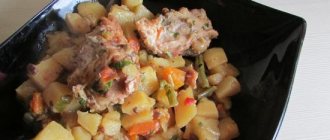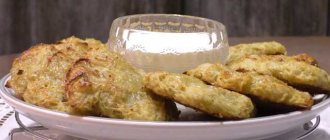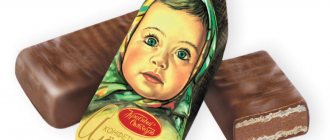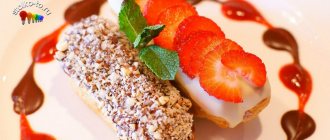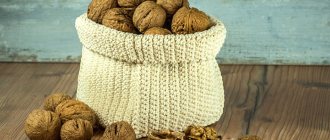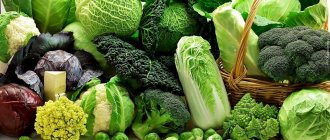Cashew nuts are native to South America and Asia. They have become popular all over the world due to their delicate, rich taste and high nutritional value. The fruit kernels are often used fried, dried or raw. They are a flavorful addition to desserts and main courses. Candied nuts are a wonderful treat. One serving contains a significant amount of calories. The product saturates the body with healthy fats, minerals, proteins, and carbohydrates.
Botanical description
The cashew nut grows on a tropical evergreen tree called cashew occidentalis. Other names for the plant are “acajou”, “caju” and “Indian nut”. Its average height varies from 12 to 15 m, although in the wild it can reach up to 30 m. The trees are characterized by a lush, spreading crown that bends low to the ground. It is interesting that the branches of some species of anacardium (in particular, “Pirangi”) are able to “send” roots when located close to moist soil. At the same time, not far from the “mother” culture, new shoots appear, producing young shoots [1][4].
Cashew leaves are dense, elliptical and bright green. The length of the plates is 4-20 cm, width – 2-12 cm [1][4].
The crop blooms from 1 to 3 times a year, depending on the variety and growing conditions. The corollas of anacardium are yellowish-pink and consist of five pointed petals (7-15 cm long). In place of fading flowers, edible ovaries appear, called “cashew apples.” They have a bright yellow or orange-red color. The pulp of “cashew apples” is juicy and fleshy with an aromatic sweet and sour astringent taste. In tropical countries, compotes, jams, smoothies, jellies and juices are prepared using them. However, these ovaries are “pseudofruits”, since they represent an overgrown receptacle. True acajou nuts are located at the very end of the stalk. On top they are covered with a green shell containing phenolic resin, and inside with a dense, rough shell, under which the edible kernel is hidden. The average weight of one nut is 1.5 g. The yield of this crop is 780 kg per 1 ha [1][4].
The natural habitat of acaju is Brazil. Along with this, the plant is cultivated in more than 30 tropical countries of the world: South America, West Africa, Southeast Asia. The largest exporters of the product: Vietnam, India, Malaysia, Nigeria, Brazil, Thailand, Indonesia, Philippines, Azerbaijan [1][4].
Calorie content and nutritional value of cashews
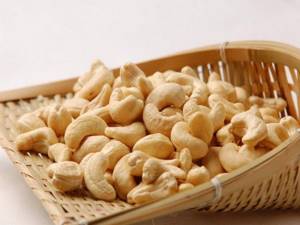
Cashews are characterized by a high fat content. But it is precisely this factor that helps to get rid of excess weight. It is important not to overuse the healthy product and follow the recommendations of nutritionists. The weight of one nut is 1.2 g, which means its calorie content reaches 7.56 kcal (raw).
Cashew BJU has a ratio in the following proportions: 1:2.6:1.2. The calorie content of BJU per 100 grams of product is shown in this table:
| Nuts | Proteins (g) | Fat (g) | Carbohydrates (g) | Calorie content, kcal |
| Raw cashews (100 g) | 18,5 | 48,5 | 22,5 | 650 |
| Roasted cashews (100 g) | 17,5 | 42,2 | 30,5 | 580 |
The energy value of raw cashews is 650 kcal. In roasted nuts it is reduced to 580 kcal. The calorie content of dried cashews is 586.33 kcal.
Chemical composition
Cashews are a high-calorie product with a nutritional value of 553 kcal. The energy ratio B:F:U is 12%: 73%: 15% [2].
Cashew fruits have tonic, antibacterial and antiseptic properties.
They are used to treat metabolic disorders, dystrophy, psoriasis and anemia [5]. Table No. 1 “Nutritional value of cashew fruits”
| Components | Content per 100 g of product, grams |
| Fats | 43,85 |
| Carbohydrates | 26,89 |
| Squirrels | 18,22 |
| Water | 5,2 |
| Alimentary fiber | 3,3 |
| Ash | 2,54 |
Table No. 2 “Chemical composition of cashew fruits”
| Name | Nutrient content in 100 g of fresh fruits, milligrams |
| Vitamins | |
| Niacin (B3) | 1,06 |
| Tocopherol (E) | 0,9 |
| Pantothenic acid (B5) | 0,86 |
| Pyridoxine (B6) | 0,42 |
| Thiamine (B1) | 0,42 |
| Ascorbic acid (C) | 0,5 |
| Riboflavin (B2) | 0,06 |
| Phylloquinones (K) | 0,034 |
| Folate (B9) | 0,025 |
| Retinol (A) | 0,022 |
| Macronutrients | |
| Potassium | 660 |
| Phosphorus | 593 |
| Magnesium | 292 |
| Calcium | 37 |
| Sodium | 12 |
| Microelements | |
| Iron | 6,68 |
| Zinc | 5,78 |
| Copper | 2,19 |
| Manganese | 1,66 |
| Selenium | 0,012 |
Table No. 3 “Amino acid composition of cashew fruits”
| Name | Content of protein structures in 100 g of nuts, grams |
| Essential amino acids | |
| Arginine | 2,13 |
| Leucine | 1,47 |
| Valin | 1,09 |
| Phenylalanine | 0,95 |
| Lysine | 0,93 |
| Isoleucine | 0,79 |
| Threonine | 0,69 |
| Histidine | 0,46 |
| Methionine | 0,36 |
| Tryptophan | 0,29 |
| Nonessential amino acids | |
| Glutamic acid | 4,51 |
| Aspartic acid | 1,78 |
| Serin | 1,08 |
| Glycine | 0,94 |
| Alanin | 0,84 |
| Proline | 0,81 |
| Tyrosine | 0,51 |
| Cysteine | 0,39 |
The composition of cashew fruit bodies includes esters, tannins, phenolic resins, terpenes, and carboxylic acids [2][6].
It is interesting that in Africa the nut is used as a means for tattooing, in Mexico - to discolor freckles, in Haiti - to remove warts, Venezuela - to treat wounds, Peru - to treat the throat, Brazil - to increase potency, fight diarrhea, diabetes and asthma.
Summary
- The benefits of cashews for all categories of people are undeniable, and a big advantage over other types of nuts is their low tendency to cause allergic reactions.
- The high magnesium content helps eliminate seizures and improve the functioning of the nervous and cardiovascular systems.
- The unique amino acid composition, the presence of omega-3 fatty acids and other characteristics indicate undoubtedly benefits, but do not forget about the other side of the coin: the high calorie content means that you should not consume more than 10 nuts per day.
Beneficial features
Considering that more than 70% of the lipid composition of cashews consists of unsaturated fatty acids, acaju nuts are excellent suppliers of “fuel” to the human body. In addition, they support the vital activity of cells, increase the level of skin hydration, normalize cholesterol metabolism, participate in the construction of enzymes and hormones, and protect internal organs from mechanical injuries. Along with this, the usefulness of nuts is due to their rich amino acid and vitamin-mineral composition [3][7][8].

Effects of consuming cashew fruits:
- They improve the functional state of the brain, increase mental performance, and stress resistance.
- Accelerates the healing of erosions, ulcers and open wounds.
- Reduces body temperature (acting as a coolant).
- Strengthens the heart muscle.
- Normalize lipid metabolism and accelerate metabolic processes.
- Improves rheological parameters of blood.
- Activate energy exchange in tissues.
- Accelerate the removal of excess fluid from the body.
- Promote weight loss (by stimulating fat burning).
- Reduce bleeding gums and strengthen tooth enamel.
- Stimulates the production of hormones and digestive enzymes.
- Increase vitality.
- Reduce the permeability of the capillary wall.
- They stimulate the utilization of metabolic products, natural antiviral immunity, and block the proliferation of pathogenic bacteria.
- Promote the proper formation of feces.
- Improves the appearance of nails and hair, eliminates acne.
Along with this, cashew has antibacterial, anti-inflammatory, diuretic, hypotensive, astringent, tonic and antiseptic effects [3][7][8].
It is advisable to consume Indian nut for hypothyroidism, diabetes, anemia, hypertension, bronchitis, psoriasis, depression, flu, anxiety, dystrophy, stress, toothache, hypercholesterolemia. The optimal daily dose is 30 grams [3][7][8].
However, despite the usefulness of the product, there are contraindications to its consumption.

Cashew intake is limited to:
- kidney or bladder stones;
- pancreatitis;
- stomach ulcer;
- obesity;
- migraines;
- predisposition to allergic reactions.
In addition, fresh fruits contain phenolic resin, which is toxic to the human body. Therefore, when visiting tropical countries, you should not pick fruits from the tree or try to remove nuts from the shell. If the skin comes into contact with any parts of a fresh plant, including bark and leaves, allergic reactions may occur (dermatitis, laryngeal edema, asthma attacks) [1].
Remember, consumption of fresh cashew nuts is fraught with severe poisoning, and in severe cases, death. In this regard, only purchased peeled fruits that have undergone a special heat treatment cycle (in production) are eaten [9].
Why do they say that raw kernels are poison?
It is not the raw acaju kernel that is poisonous, but the contents of the pericarp. Between the peel and shell of the Indian nut there are caustic substances - anacardic acid and cardol. Oily liquid containing these substances causes severe irritation and burns. To obtain edible kernels, there are 2 processing methods :
- The nuts are manually cracked using special devices . Then the kernels are subjected to heat treatment to remove the acid that has fallen on them, calibrated and packaged. The shell is also processed, obtaining 2 fractions. Solids are used in the automotive industry to make brake pads. Liquid containing toxins - in pharmacology and the chemical industry for the production of phenylamine.
- Toxic substances are disposed of before the nut is cracked . The nuts are first softened in boiling water and then dried in an oven at 125°C. Toxic oils evaporate, making the fragile shell easier to crack. Clean kernels are also sorted and packaged.
Nuts obtained using the 2nd method are considered raw, since it is not the kernels themselves that are heat-treated, but the shells.
Application in cosmetology
To maintain beauty, cashew kernel oil is used, obtained by cold pressing. It is excellent for caring for dry, combination and problem skin [10][11].
Effects of using nut concentrate:
- Accelerates the healing of wounds and microcracks in the skin.
- Dries out acne.
- Smoothes out a network of fine wrinkles.
- Protects the dermis from adverse environmental factors (sun, wind, frost).
- Eliminates peeling, irritation and burns of the skin.
- Improves complexion.
- Stimulates hair growth.
- Reduces fragility of nail plates.
- Increases the elasticity of rough feet, softens corns and calluses [10][11].
Cashew fruit concentrate is used both in pure form and in combination with fatty or essential oils. In addition, massage mixtures, nourishing masks, emollient creams, antifungal agents, anti-inflammatory compounds, rejuvenating emulsions and regenerating balms are created on its basis [10][11].
Recipes
Nourishing hair mask

To prepare the composition you will need: 100 ml of soap base (shampoo, conditioner, balm) and 10 ml of cashew butter. The resulting mixture is applied to a washed (damp) head, lightly massaging the scalp. Leave the mask on your head for no more than 15 minutes. With regular use of the composition, the hydrolipid balance of the skin is normalized and hair follicles are strengthened.
Hand softener
Acaju nutritional extract is used both in pure form and in combination with transport oils (olive, jojoba, peach kernels, wheat germ). To strengthen the nail fold and eliminate peeling, the mixture is applied to damp skin at least 2 times a day.
Relaxing body bath
To eliminate insomnia, nervousness and fatigue, mix 2 drops of geranium, chamomile and lavender ether with 15 ml of cashew oil (refractory). The specified mixture is poured into a warm liquid (38 degrees), after which the water is thoroughly mixed by hand. The duration of the therapeutic bath is 10-15 minutes.
Anti-inflammatory face masks
To “fight” problem skin (acne, flaking, pimples), mix 10 ml of cashew and jojoba oils. Then camphor and eucalyptus ether are added drop by drop to this mixture. A napkin is moistened with the resulting composition and applied to the problematic skin for 15 minutes.
Remember, before the procedure, the dermis should be thoroughly washed with a cleanser.
After-sunburn mixture
Combine 15 ml of nut fat with 2 drops of rose or lavender essential oil. Apply the resulting product to the affected areas of the body four times a day.
In addition, cashew oil is used to treat warts, blisters, psoriasis and eczema (in combination with lavender, lemon balm and tea tree esters)
Contraindications
Anacardia should not be consumed if you have an allergy. A relative contraindication is obesity. Overweight people are allowed to eat cashews only in small portions. It is best to use it as part of a weight loss diet.
Maranhaan shells can be harmful to health - they contain cardol and anacardic acid. These substances are toxic and cause severe burns if they come into contact with the skin. That is why cashews are sold only in purified form.
You should not use nuts as an independent medicine in the treatment of serious diseases. You can get rid of them only with the help of properly administered drug therapy. Cashews can be used only as an additional remedy to the main treatment, or for preventive purposes.

Growing at home
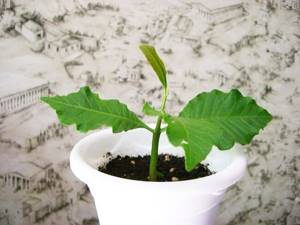
Despite the fact that anacardiums are tropical plants, they are successfully cultivated in the mid-latitude zone. At the same time, it is not difficult to create a comfortable microclimate for a tree at home [12].
Preliminary seed preparation
For planting plants, it is better to use purchased material from trusted manufacturers. Before germination, the seeds are kept in warm water for two days. Considering that unshelled nuts contain toxic substances, after 7-10 hours the liquid becomes inky blue in color. To remove harmful toxins, the source water should be changed at least 2 times a day [13].
When working with seeds, it is important to wear rubber gloves, since contact of the poison with the skin will cause a painful burn.
Substrate preparation
To ensure good seed germination, use loose soil saturated with minerals. The optimal container volume is 1 liter. In this case, the pallets are pre-filled with pebbles (to maintain a constant level of humidity) [13].
Planting seeds
The soaked cashew fruits are placed one by one in the prepared substrate (one per pot). After this, the containers are placed in a well-lit place. After 20 days, the seedlings produce their first shoots [13].
Seedling care
To form a full-fledged plant, it is important to maintain high moisture in the root layer of the soil, as well as spray the above-ground part of the seedling twice a day and add water to the trays with pebbles. To give the tree a beautiful shape in the first year of its “life”, it is pruned. The young plant is fed 6 months after planting with universal fertilizers for fruit-bearing crops (once every 30 days).
With proper care, anacardiums bloom in 3-4 years of life. However, to obtain fruit ovaries, it is sometimes necessary to resort to artificial pollination [13].
Fried
Fried cashews have a wonderful taste and aroma, dull the appetite well and make dishes with them more satisfying and nutritious. Although the beneficial properties of roasted nuts are somewhat lower compared to fresh ones, their taste is higher. In terms of calorie content, fried Indian nuts are almost equal to fresh ones - 536 kcal/100 g, per 1 piece. contains approximately 6.86 kcal.
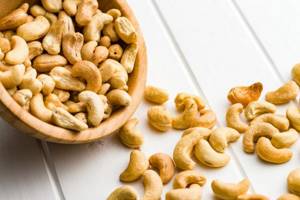
There are two types of frying - dry and with the addition of oil; the second method, naturally, greatly increases the calorie content of the product. If the nuts are roasted for a short time, about 15 minutes, and at a low temperature (120-140°C), the loss of vitamins and other beneficial substances will be minimal.
Fried anacardium can serve as:
- separate snack;
- a side dish for meat or fish;
- ingredient in cereal porridges;
- component of vegetable and fruit salads;
- Whole or crushed roasted nuts are used to decorate cakes.
A popular dessert is cashews coated in sugar and honey or chocolate. To do this, pour the nuts into a cup with liquid honey, mix gently and leave for 12 hours. Then roll in powdered sugar and fry in vegetable oil until the sugar caramelizes and becomes transparent. To prepare nuts in chocolate, you need to fry them, then immerse them in black or milk chocolate melted in a water bath for a few minutes, and then carefully place them on a napkin until the chocolate layer hardens.
Dishes
Anacardium is present in the national cuisine of Georgia, India, Turkey, Nepal, and Thailand. In Asian cuisine, cashews are added to soups and main courses, and they are used to make original snacks and delicious desserts. The Indian nut contains a lot of starch, so it is used as a thickener for making sauces and puree soups.
Raw food cream soup
Grind in a blender:
- 150 g raw cashews;
- 500 g broccoli;
- half an avocado;
- onion;
- a bunch of green coriander.
Add 2 cups of water to the mixture and stir. Serve cold. Calorie content of a serving of soup is 398 kcal.
Asian chicken breast
Ingredients:
- chicken breast 300 g;
- sweet pepper 2 pcs.;
- raw anacardium 0.5 tbsp.;
- green and onions;
- garlic;
- soy sauce;
- olive oil.
Cut the chicken into small pieces and place in a marinade made from soy sauce, oil and chopped garlic for several hours. Fry the chicken until golden brown, then add slices of bell pepper, finely chopped onions, green onions to the pan and fry for another 3-5 minutes. The last thing to add to the pan is the nuts; keep the dish on low heat for 7-10 minutes, stirring occasionally. Calorie content per serving: 799 kcal.
Eggplant with cashews
Ingredients:
- eggplant;
- raw cashews;
- green cilantro;
- cumin and mustard seeds;
- turmeric;
- ground black pepper;
- vegetable oil.
Place one chopped eggplant and mustard seeds in a thick-walled bowl with heated oil and fry until half cooked. Then add ¾ cup of nuts and cook over low heat until the eggplant is soft. Add salt, pepper, turmeric powder, chopped coriander and remove from heat. The calorie content of the dish prepared according to this recipe is 428 kcal.
Pilaf with nuts and vegetables
Ingredients:
- Brown rice;
- cashew nuts;
- green pea;
- zucchini;
- carrot;
- Bell pepper;
- olive oil;
- curry seasoning
Place 2 cups of rice, 1 cup of nuts, 4 cups of water into a thick-walled saucepan or multicooker container. Turn on the “pilaf” mode and cook until the rice has absorbed all the water. Cut and stew in a frying pan 1 carrot, 1 pepper, ½ cup peas, 1 zucchini. Add stewed vegetables to the container and cook until the rice is soft. The calorie content of a serving of pilaf is 459 kcal.
Cauliflower with green sauce
Ingredients:
- cauliflower;
- cashew nuts;
- coriander;
- lemon juice;
- dill, parsley.
Cut 500 g of cauliflower into florets and boil in salted water until soft. Grind a glass of nuts in a blender and mix with ground coriander, lemon juice and cabbage broth to form a thick paste sauce. Place the boiled cabbage on a plate and pour over the sauce. Calorie content per serving: 723 kcal.
Hungarian pate
Ingredients:
- cashew nuts;
- chicken eggs;
- bulb onions;
- dill greens;
- mayonnaise.
Grind fried onions, dill, 3 boiled eggs and ½ cup cashews in a blender. Add mayonnaise and mix thoroughly. Calorie content of a serving of pate is 299 kcal.
Cake shake
This dessert dish is popular in France. The cake is prepared without baking and consists of 3 layers. The bottom layer is dates and almonds crushed in a blender, the middle layer is a cream made from mashed cashew nuts, honey, coconut milk and lemon juice, the top layer is the same cream mixed with a small amount of strawberries, blackberries or raspberries.
The calorie content of a serving of dessert is 656 kcal; to prepare it you will need:
- 80 g each of dates and almonds;
- 250 g cashews;
- lemon;
- 2 tbsp. l. honey;
- 0.5 cups coconut milk;
- a glass of fresh strawberries, blackberries or raspberries.
Raw food dessert

For this exotic dish you will need:
- 1 cup fried anacardium;
- 300 g pitted dates;
- 1 banana;
- 1 tsp. ground coffee.
Preparation:
- Peel the banana and cut into small pieces.
- Grind half a cup of cashews in a blender and mix with ground coffee.
- Soak the remaining nuts in water for half an hour and grind together with the dates.
- Make small balls from the date-nut mixture, placing a piece of banana in the middle of each.
- Roll the balls in cashew and coffee breading and place in the freezer for 1 hour.
The calorie content of a serving of dessert is 200 kcal.
